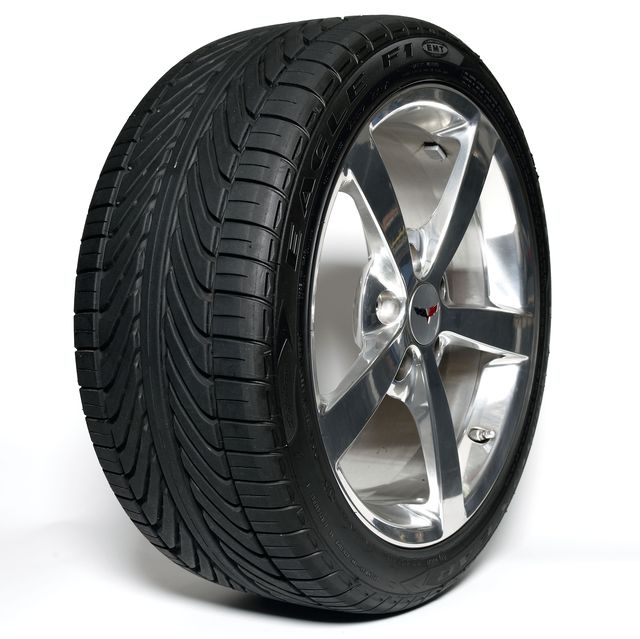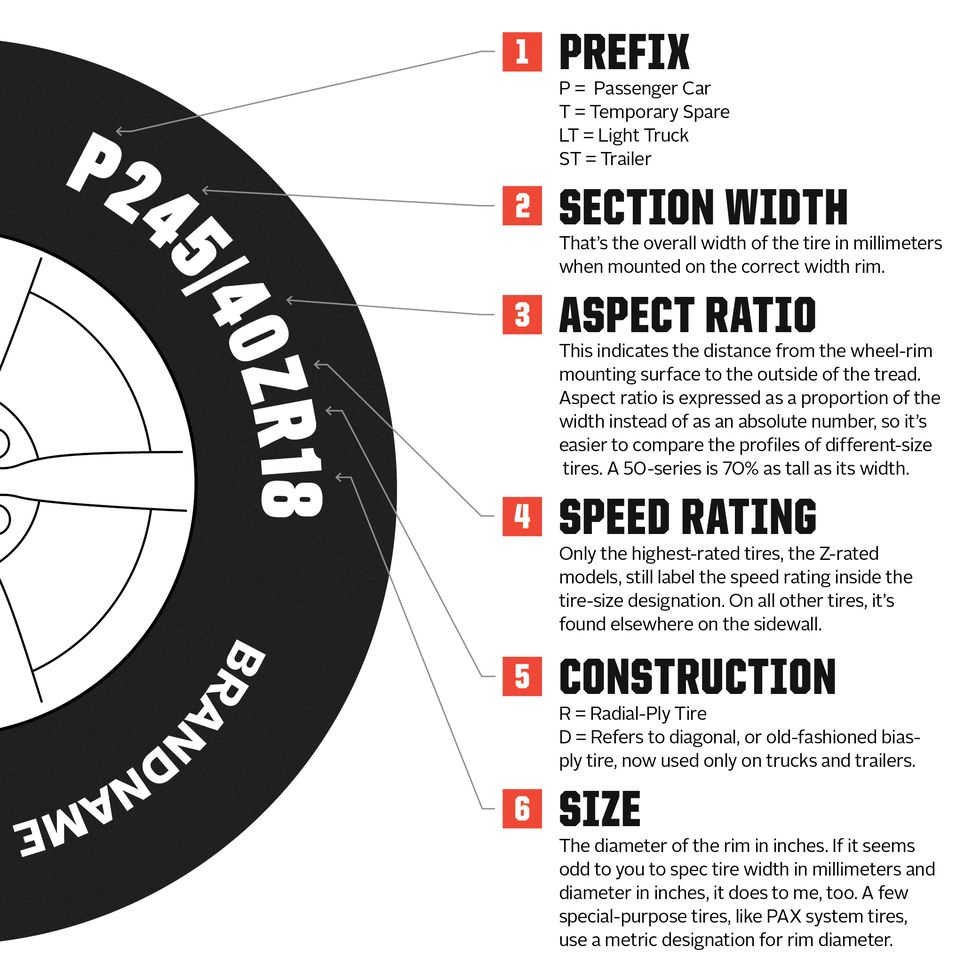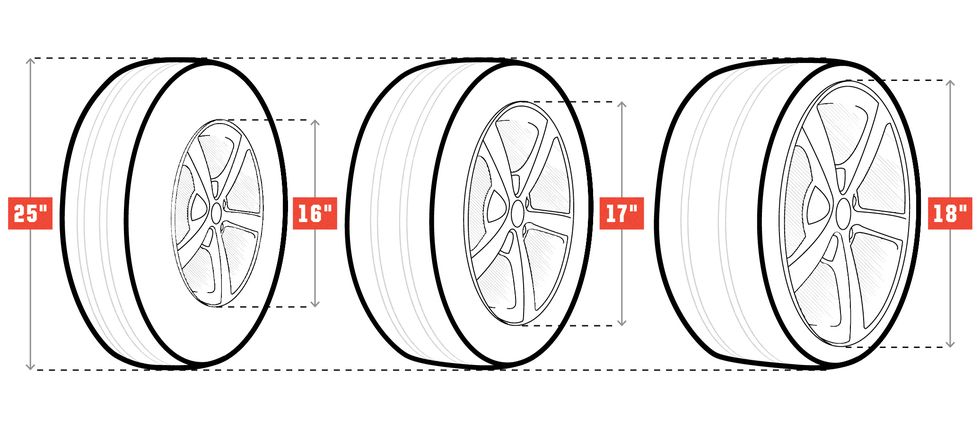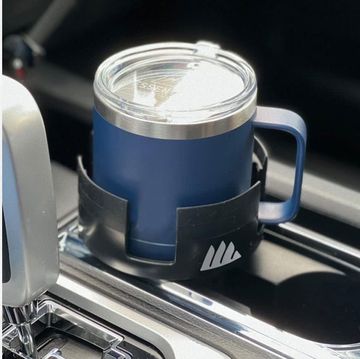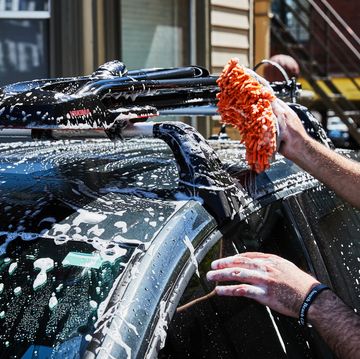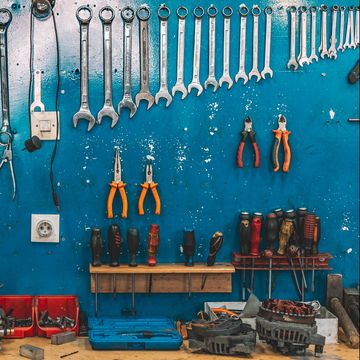The most important pieces of real estate on your car are those four small contact patches that grip the road: your tires. Those few square inches of rubber determine just about everything. Tires harness the engine's power, allow the brakes to do their job and determine how successfully a car will go around a corner regardless of whether they’re pulling into a parking stall or screaming into a high-speed sweeper.
Yes, tires carry an enormous burden. That thin doughnut of round and black is a complex assembly of cables, rubber and polymers, all molded into a highly engineered profile. It's then mounted onto a wheel and, of course, inflated with air to give it shape and definition. The manufacturers behind your vehicle, tires and wheels worked together to carefully engineer an optimum combination of grip, road feel, ride quality, noise control and tire wear.
In America, “bigger is better” has been the prevailing trend over the past couple decades. “22s on Porsche trucks” used to be a flex worth rapping about—now it’s a factory option. Big wheels aren’t just the domain of performance enthusiasts looking to fit larger brakes and tires anymore. Sometimes they simply look cool, especially with the taller dimensions of a modern-day car. Just think of how strange a 2020 Mazda Miata would look wrong with the 14-inch stock wheels from its early 90s counterpart. From a design perspective alone, it just wouldn’t work.
Yet there are also practical, everyday reasons why you may want to swap your car’s tires and wheels, too. Some drivers now want to buck the trend of larger, heavier wheels whose low-profile tires are more expensive to replace and don’t offer much cushion on rough roads. Picking up a spare set of wheels and tires to use during the summer or winter is popular in colder climates as well. Why ruin a nicer set of wheels with road salt and grime if you don’t have to?
Bigger is not always better. There's a sizing sweet spot that provides better grip and those head-turning looks without compromising your vehicle's original engineering. So, let's get some basics down before you upgrade to new rolling stock.
Of Wheels and Humanity
The first known wheels were made of wood, despite what Fred Flintstone's granite-shod convertible would have you believe. Automobiles even used wooden carriage wheels for quite a while. Increased power and weight soon outstripped wood's capabilities, and wheels were upgraded to steel, either in a stamped, welded dish or a lighter hub, spoke and rim design. Lightweight steel-spoked wheels lingered until the 1950s, especially on nimble foreign sports cars, but larger American cars needed the stronger stamped and welded wheels.
Steel's weight penalty led racers and enthusiasts to explore magnesium—a metal as strong as aluminum, but even lighter. Unfortunately, pure magnesium corrodes very easily unless it's properly sealed and can even catch fire in an accident. Magnesium wheel fires are still singled out in firefighting courses today, as taking a water hose to a burning magnesium wheel only makes it burn more intensely. These earlier magnesium wheels didn’t get much use outside of racing because of these on-road liabilities.
What some old-schoolers call "mag" wheels today are actually a safer, more stable magnesium alloy or more frequently, an aluminum alloy that’s been painted or chromed. Beyond these alloys, there are now ultra-lightweight carbon-fiber wheels, but those are still far more expensive than an alloy set. For now, most wheel upgrades involve aluminum alloys.
How Much Rubber Do You Need?
One of the reasons why people opt for larger wheels and tires revolves around the contact patch—specifically, how much tire touches the ground at any given time. Maybe you’ve upgraded your engine for more power and now your tires break loose if you just look at them funny. You’re going to need more contact with the ground (and thus, more grip) in order to use that extra power for more than sick burnouts.
There are two ways to increase the size of the tire's contact patch: make it longer or wider. A longer patch of tire tread means that the tire's overall diameter increases. This works better on a four-wheel-drive truck, but if you increase the diameter of the tire on most passenger cars, you’ll have problems.
First, there’s the obvious issue. The tire can rub other parts of the car, like the wheel well.
Secondly, because the radius of the overall tire is larger, the car’s effective gearing gets taller, which robs it of acceleration. Gear ratios are usually written like “4.10:1.” The higher the first number is, the more that gear multiplies the input torque that ultimately spins your wheels. Problem is, it takes longer for a larger diameter tire to complete one rotation.
Parsing the Sidewall: What Those Numbers on the Side of Your Tire Mean
So, if your gearing is set up to rotate the wheels a certain number of times with a smaller-diameter tire, using that same gearing with a larger-diameter tire won’t rotate that tire as many times. Your 4.10:1 gear ratio may effectively be a “taller” 3.75:1 ratio because of that larger tire diameter, thus slowing you down. (There are handy calculators online for how a change in tire size affects your gear ratio if you’re serious about modifying your car’s gearing to compensate for this.)
Furthermore, your car’s anti-lock brake system isn’t calibrated to handle the increased angular momentum from all that extra spinning weight concentrated near the rim and it can malfunction as a result. You may not notice this until you hammer the brakes going into a slippery corner and slide off into a hedge.
So, on street cars, we customarily go wider with wheels and tires to increase the size of that contact patch. While you still need to ensure that wider tires will fit inside your wheel wells without rubbing, it’s common to add an inch of width to your wheels—for example, going from a 7-inch-wide rim to an 8-inch-wide one. That allows a wider tire to be mounted.
While you’re adding width to your wheels, you may also want to increase your wheels’ diameter. Then you can fit a tire with a wider tread and a lower profile for better handling. Thanks to the lower profile, the overall diameter of your wheel and tire combo stays pretty close to what it was before. Adding an inch in wheel diameter but subtracting that inch from the sidewall of the tire is called a Plus 1 upgrade as it’s pretty common. Similarly, we can usually go even lower in profile with a Plus 2 (for example, going from 16- to 18-inch wheels) or Plus 3 (16- to 19-inch) upgrade on most vehicles without running into a problem.
The same principle of changing an inch in wheel diameter but compensating for that inch in the height of the tire’s sidewall can be applied to downsizing your wheels as well. Keeping the overall diameter of your tires the same also means that you won’t notice any changes in your speedometer. Speedometers usually calculate your car’s speed by measuring how often your wheels are spinning. If a significantly different tire diameter causes your wheels to turn more or less frequently than it used to, your speedometer won’t give you an accurate speed.
Wretched Excess
There are reasons to be cautious about up-sizing your wheels and tires, especially with less powerful cars. Wider tires have more rolling resistance than their skinnier counterparts, which can negatively affect your fuel economy. More mass from heavier wheels can have negative consequences as well. As noted, their extra momentum can mess with safety features like ABS, but the extra weight also requires more power to move, which wrecks both your fuel economy and your acceleration. Those wheels’ extra unsprung weight can also overwork your factory springs and shocks.
As the aspect ratio of a tire drops—that’s the lower profile we’ve been talking about—a number of things change. Shorter sidewalls are stiffer and less compliant, so the tread itself moves less. This in turn improves grip and enhances road feel through the steering wheel. That's good!
A Guide to Plus Sizing
However, the contact patch becomes more square than oval. That increased width of the tire on the pavement makes the tire more prone to hydroplaning on wet roads. Even at modest speeds, there’s a higher chance for the rubber to ride on top of the water instead of piercing through the water to the pavement. This reduces grip to nearly zero, which is a Very Bad Thing.
At the same time, ride quality suffers. One major downside to shorter sidewalls is the increased risk of wheel damage. Those short sidewalls put the rim of the wheel much closer to potholes and curbs.
A short, wide contact patch has more contact area on the road, but that's only if the wheel remains perpendicular (or nearly so) to the ground. The suspension's job has just gotten tougher. A taller, more compliant sidewall deflects more, and thus, has an easier time keeping the contact patch on the ground. With a wider patch and more grip, the car’s body rolls more, lifting the inner part of the tread off the pavement and reducing its grip. Without returning the suspension, handling can actually suffer.
It’s All About Geometry
There’s one more thing you need to be careful with when shopping for new wheels and tires: how does it all fit?
Many cars use a centering hub, which is a raised center section of the hub that mates with a matching recessed part of the wheel. It's intended to keep the wheel precisely centered on the hub, more so than by just tightening the lug bolts. Some wheels may not fit this hub properly, requiring the use of a spacer or even a different wheel.
Furthermore, the new wheel has to have the correct offset to clear the suspension and brakes. The offset is the distance from the hub mounting surface and the wheel’s centerline, which is the middle point between the rims. It measures where the tire sits laterally from the hub of the wheel.
Don't Get Rubbed the Wrong Way: Maintaining Adequate Clearance
If the rim is wider than stock, there may not be enough clearance to the ball joint or steering arm to permit half the extra width to go inside the wheel well. It may even rub the fender! Worse yet, significant size changes can upset steering geometry and overstrain wheel bearings. (As with effective gear ratios, there are online calculators that show you exactly how a change in wheel and tire size affects your steering geometry and handling.)
Our advice: Purchase a proven wheel-and-tire combo specifically designed for your vehicle, or go to a shop that specializes in modifying your kind of ride. Places like Tire Rack offer myriad wheel and tire combos based on your specific car and its dimensions. That being said, when wheels come in designs ranging from cute teddy bears to gladiator-like protruding wire hubs, we can’t blame anyone for wanting something more custom.
If you make significant changes to your wheels, you follow it up with the appropriate changes to the rest of your vehicle so that everything works safely as it should.
Stef Schrader routinely breaks and attempts to take project cars on race tracks. She enjoys fancy cheeses, good coffee, fast Porsches, traveling to new places and rare, weird cars. She lives with a large collection of Fisher-Price Puffalumps and an overloaded parts shed.
